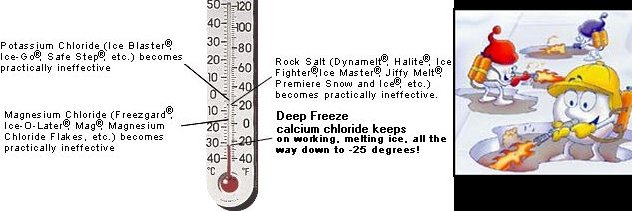
Deep Freeze
Snow & Ice melter

Deep Freeze ice remover pellets have been one of the most popular ice melting products for use on steps, walks, and drives around commercial, industrial, and institutional facilities for more than 40 years. A review of the physical properties of this unique material explains why.
Deep Freeze is a naturally-occurring material found in liquid brine deposits. Deep Freeze pellets are produced by removing the water and other materials found in the brine and compressing the dry material into the familiar pellet shape. Deep Freeze contains 90-91% calcium chloride.**
The fact that Deep Freeze occurs in nature as a liquid is significant. In technical terms, Deep Freeze is hydroscopic and deliquescent. This means it attracts moisture and readily goes into solution as it constantly tries to return to its natural liquid state. This is critical in ice melting, since solid materials are incapable of melting snow or ice. In fact, little melting even occurs. It is actually a dissolution process. Any deicer must first attract sufficient moisture to form a brine. The brine lowers the freezing point of water and dissolves snow and ice on contact. Deep Freeze ability to attract moisture is one reason why it is the fastest-acting ice melter. It simply becomes a brine faster, even in freezing temperatures when it is unlikely to come into direct contact with "free moisture." It brings moisture to itself.
Next, as Deep Freeze snow melt attracts moisture and goes into solution, it causes an exothermic reaction. This means heat is given off as the dissolution process occurs. And this is another reason why Deep Freeze works faster than other ice melters. The reaction is a powerful one, too. A pound of Deep Freeze gives off 290 BTUs as it dissolves, enough heat to raise the temperature of one gallon of water by 35° F (i.e., 32°F to 67°F).
The next important property is the freezing point of Deep Freeze ice melt. The lowest temperature at which it remains a brine is -59° F. This is its eutectic temperature and it only applies to a specific concentration of Deep Freeze in water (29.6%). But the lower the eutectic temperature, the lower the effective temperature of the deicer. In the case of Deep Freeze, it remains capable of fast action in field conditions even at -25° F.
The lower freezing point and constant thirst for moisture also allows Deep Freeze to provide long-lasting action. Even when diluted to a 20% concentration it remains effective to -4° F.
Of course, it may seem that a material that so aggressively attacks snow and ice might also pose a threat to concrete and plants alongside walks and drives. In fact, Deep Freeze has been proven to be less harmful to concrete in tests using ASTM C-672-76, "Test for Scaling Resistance of Concrete Surfaces Exposed to Chemical Deicers." It has also been found to pose little threat to plant life in tests conducted by the Iowa State University Department of Horticulture. Ironically, a big part of the reason why Deep Freeze is so easy on concrete and plants is because its so effective at melting snow and ice. Its recommended application rate is typically only one-third to one-half that of other products, just 2-4 ounces per square yard.
Another common deicer concern is the result of the inevitable tracking of deicer brine inside buildings. And another reason for the popularity of Deep Freeze snow melter pellets is that it does not create a powdery white residue on flooring.
A final note relates to the shape of Deep Freeze ice melter pellets. Round pellets have a distinct advantage over flakes and irregularly-shaped granules. Round pellets contact a very small area of ice and spend their time boring vertically downward. Flat particles tend to work as hard horizontally as vertically. Since the goal is to penetrate ice and snow and break the bond with the pavement, its better to have a pellet-shaped material that penetrates downward faster.
In short, the reasons for the long-standing preference for Deep Freeze snow & ice melter pellets are its unique combination of physical properties. But they all boil down to this: Deep Freeze works faster at all winter temperatures, melts more, works longer, does not leave a powdery residue, or pose a significant threat to concrete surfaces or plant life. Users can use less and they have a product that is effective over a wider range of winter conditions.
LYN DISTRIBUTING
MAIN PAGE SDS
Purchase on line here